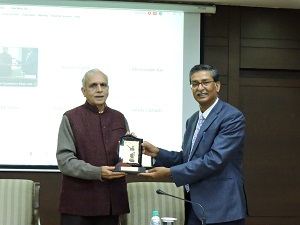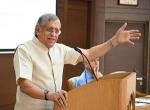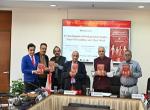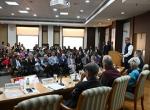On 7th February, 2023 Vivekananda International Foundation organized a Vimarsh, a monthly talk series, on “Water Security in India”. Shri Bharat Lal, Director General, National Centre for Good Governance, Department of Administrative Reforms & Public Grievances, Government of India (GOI) was the guest speaker for the event. Dr. Arvind Gupta, Director of VIF, delivered the opening and welcome remarks and he also chaired the proceedings.
Introduction to the Speaker and Opening Remarks
During the opening remarks, Dr. Gupta welcomed the speaker and gave his brief point of view on the subject. Dr. Gupta stated that Mr. Bharat Lal is a senior civil servant who joined the Indian Administrative Service in 1988 and has occupied several senior positions both in the state government in Gujarat and also in the Central government. Mr. Lal has a vast experience in policymaking at the highest levels on a variety of national and international issues. He has worked in the core team which was managing the Covid-19 crisis. His work in Gujarat in setting up the Water and Sanitation Management Organization also known as WASMO in 2002 after the earthquake has won him several laurels including Prime Minister’s Civil Service Award as well as the United Nations Public Service Award. He also conceptualized Gujarat’s Chiranjeevi Yojana which was universalized under the National Rural Health Mission which has had a deep impact on the Infant Mortality Rate (IMR) and also the Maternal Mortality Rate (MMR) vaccine program. Mr. Bharat Lal was also the Additional Secretary to the President during 2017-19. He was also the founder Mission Director of ‘Jal Jeevan Mission’ which was launched in 2019 and the mission aims at providing clean tap water to every household and public institution in the country by 2024.
After introducing the speaker, Dr. Gupta delivered his brief point of view on the subject.
Dr. Gupta stated that it was no exaggeration to say that India is facing an acute water crisis at the moment. More than 600 million people are facing acute water shortages in the country. The per capita availability of water has come down to 1000 m3 from 5000 m3 in 1947. This is roughly the level where we can call India aswater stressed country. Climate change and extreme weather events have created a deep uncertainty on the water situation in the country. India is ranked 120 among 122 countries in the water quality index. It is estimated that India’s water demand will exceed supply by a factor of two by 2030. 40 percent of the population will have no access to drinking water by 2030. Major cities are running out of groundwater. Indian rivers are highly polluted. Critical groundwater resources which account for 40 percent of our water supply are being depleted at unsustainable rates. Clearly, we have to act now to rescue the country from the ongoing water crisis. However, it is a matter of great satisfaction that in the recent years the gravity of the situation has been understood and a number of steps have been initiated. The launch of programs like the Jal Jeevan Mission (JJM), Atal Bhu jal Yojana (Atal Jal), Jal Shakti Abhiyan, Pradhan Mantri Krishi Sinchayee Yojana (PMKSY) is some of the steps in that direction. Dr. Gupta also raised an important point regarding the future of these programs and its effectiveness. According to him, it was time for us as a country to start thinking on these lines.
Address by the Speaker
In the next one-hour lecture, the speaker delved upon many significant points related to water security of India. The speaker started off by saying that his remarks will be based on whatever he has learnt as the idea is that the people should try to see that how scarcity of water can impact and, in the past, has impacted quality of life, socio-economic development, and economic growth especially in a country like India where almost 40 percent of the land falls in arid or semi-arid region and where still in 2019 only 17 percent of population had clean assured tap water supply. In his lecture the speaker has tried to give anational perspective about scarcity of waterwhich basically means that he has tried to explain as to what kind of impact water scarcity has on the country along with few examples about how this situation has been tackled at different levels. There also lies a story that the kind of place India commands today in Global South and many other parts of the world, the success stories as to how India has handled some of the crisis situation can be shared within the country as well as with the rest of the world for the larger good of the society.
In 1947, India’s average life expectancy was 32 years and the population was around 36 crores. After partition, the challenges were enormous and shortage of food grains had become very evident. This means that the focus was on food security. In the coming decades, food security became one of the major focal points when seen from water management angle. Today, India has achieved food security to a very large extent. In 1947, per capita fresh water availability was 5177 m3 which came down to in 2014 around1508 m3 and it is expected that in 2024 per capita freshwater availability will be 1465 m3 and in 2050 the per capita freshwater availability will be 1235 m3. Hence, the context is that if per capita freshwater availability will come down below 1100 m3 then that region will become “water stressed” which further means that the socio-economic development and everything gets adversely impacted. An example of Israel was given by the speaker whose per capita water availability was very low but there are lessons to learn from them as they did not allow the paucity of water to become a limiting factor in their socio-economic development. So, this is one aspect which we have to keep in mind that per capita freshwater availability is at a critical stage if better management, better policy, better strategy, better implementation is not done. This has brought some kind of urgency.
The speaker also gave an example of Gujarat which has shown tremendous progress in terms of achieving water security as well as economic development. In 1999-2000, the GSDP growth of Gujarat was only 1.02%. In 2000-2001, the GSDP growth became -4.89%. There was a context to it that on 26th January 2001 there was an earthquake. If one takes five years span which is 1997-2002, the GSDP growth of Gujarat was only 2.8%. At that time more than 10,000 road tankers and two trains were deployed to transport water to different parts of the state. There were three districts in the state namely Jamnagar, Kutch and another one where since the 1971 census the population was going down because people were migrating out of these districts. If one has to find out one critical factor for this kind of situation, it was scarcity of water. However, since 2002 onwards, Gujarat has crossed double-digit economic growth. What makes the example of Gujarat unique is the fact that 70% of its land area is desert or arid and still it has managed to achieve economic growth in double digits.
Many parts of the country in states like Uttar Pradesh, Haryana, Rajasthan, Gujarat, Karnataka, Telangana, Andhra Pradesh, Madhya Pradesh, Bihar, West Bengal paucity of water is basically impacting the socio-economic development and that’s why water management becomes critical if a country has to take out vast majority of people out of poverty.
Hence, in this country there has been a case of Gujarat where the crisis has been handled carefully, it has shown the way and what we can learn. Additionally, post 2014 what kind of policies and programs are being implemented to achieve water security needs to be kept in mind.
The speaker once again reiterated and gave the example of Gujarat as to how it has achieved water security. In Gujarat, the southern part of the stateis covered in forests which acts as catchment areas and hence has plenty of water. So, the idea was to collect this water in a dam also known as the Sardar Sarovar dam which took 40 years to be completed and water was transferred to the northern areas of the state. Hence, inter-basin transfer of water is a very accepted model of water management not only in the country but across the world. The construction of this dam played a major role in bringing water security to the state. The second important thing was that instead of water being the subject of the government officials and government departments, the effort was made that it should become everyone’s business. This further meant practicing rainwater harvesting, storage of water, and judicious use of water at the individual level. The message is clear that until and unless everyone gets involved it is difficult to achieve water security. The concept was introduced that if farmers or anyone wants to construct a dam or water harvesting structure or a water storing structure, they could do it with the help of the government. In fact, a scheme called ‘Sardar Patel Sahbhagi Jal Sanchay Yojana’ was initiated where 70 percent of the cost was given to the farmers to constructa check dam. The next idea was that during monsoon, water which went into the Arabian Sea needed to be diverted to the parched land. Hence a canal called ‘Sujalam Sufulam Canal’ was constructed to divert flood water from going into the sea to north Gujarat. Additionally, the idea was also to recharge the groundwater through the water from this canal. The impact was that in nearly 5-6 years the water table in several blocks started rising. In today’s time and scenario, it is next to impossible to construct a big dam because of environmental concerns; hence, the way forward is that the existing reservoirs need to be strengthened. Thus, today the result is that the reservoirs have plenty of water and it is overflowing. The next thing which was done to make the state of Gujarat water secure is the ‘restructuring of the water sector’ so that at every level there is accountability. There was also the creation of ‘Water and Sanitation Management Organization’ (WASMO) which started hand holding people and ensuring management. This further meant that the charge of water management was now in the hands of village panchayat with every village becoming a public utility. The way the system worked was that they received raw water, treated it, supplied it to every household, ensured service delivery, attended public grievances, collected water service charges etc. This has been a very successful model in Gujarat as every household in the state now has a water supply.
Another aspect of water security which the speaker highlighted was about the use of technology and innovation. In iron and steel industry, lot of waste energy is generated. So, the concept was that sea water should be used for cooling it down and basically from evaporation distilled water which is collected should be mixed with saline water and supplied to the people. This was a win-win situation for everyone. There were also mention of desalination plants which however are expensive innovations. But most importantly these initiatives brought investments and also brought understanding of water to the people. People started using these opportunities to understand the nuances of water. The more modernization and urbanization is taking place, per capita water consumption is going up, which in turn meansthat sewage water or grey water is going to increase. Hence, it has become important that people start thinking about water management in their day to day lives then only water security can be ensured.
If we have to achieve water security, we all have to understand that there is something called ‘water cycle’. ‘Water Cycle’ is a complex process, in which liquid water evaporates into water vapor, condenses to form clouds, and precipitates back to earth in the form of rain and snow. When the water comes back to earth it needs to be collected and stored which further means that the surface needs to be clean. Hence, if you want to achieve water security, the first and foremost requisite is that the country must become open defecation free. Hence, the Swachh Bharat Mission was a part of a bigger strategy to achieve water security which is to first clean up the surface by stopping open defecation then only the country can move towards the path of water security. Additionally, the focus was also given to the rivers. River Ganga was taken up for rejuvenation. The next thing was the unification of different water related ministries and departments into one entity called the “Ministry of Jal Shakti” which was launched on 30th May 2019. Then there was the launch of the “Jal Shakti Abhiyan” which basically meant to make water everyone’s business. It was a massive campaign which was launched in 256 water stressed districts. And on 15th August 2019, the “Jal Jeevan Mission” was launched. The mission is all about ensuring clean water to everyone.
The speaker then elaborated on the Jal Jeevan Mission which was launched on 15th August 2019. He started off by saying that, at present women participation in workforce is 19 percent. If India is able to ensure tap water at home, then the percentage of women in workforce will increase drastically and this can in turn transform India as the contribution of women in economy can be transformational. And the Jal Jeevan mission is focusing on this aspect of water security. The mission ensures that more time is available with women to join workforce to make contribution in formal economy. When the Jal Jeevan Mission was launched in 2019 only 16.69% of households had tap water connection. Today, more than 11 crore families out of 19 crore families have assured tap water supply. The Mission is also making important contribution towards rural economy. The implementation of this mission is as such that the village community has to be organized. A 15-member committee also known as the “Water and Sanitation” Committee is organized in which 50% members are women. This helps in women empowerment and better management of water. In every village, five women are being trained for testing the water and at the same time they bring awareness generation about water issues, sanitation issues, hygiene issues etc. In every village almost 5-10 people are being provided with skilling courses to become plumber, carpenter, electrician etc. which further means that their income is going up. Under the Jal Jeevan Mission on priority basis roughly 51 or 52% of assured tap water supply has been given to the 60 districts of UP, Assam, West Bengal and Tamil Nadu suffering from brain fever etc. The mission also encourages inclusiveness irrespective of caste, creed and religion etc. and everyone should be provided with clean tap water facility in the rural areas. Another important thing about the mission is that water is supplied with quality, in quantity, regularly and with pressure. Hence, there was development of a sensor based IOT device which is being installed in every village with the objective of data being picked up directly. So, the focus is on service delivery and not on capital expenditure. To sustain it, there has to be three partners: a) village community, b) an NGO in the form of implementation support agency and the third is the c) engineering department. To further sustain this system an ecosystem or knowledge-based advocacy system was created. To give an example, the honorable Prime Minister of India, Shri Narendra Modi inaugurated the Dr. Syama Prasad Mookerjee National Institute of Water and Sanitation (SPM-NIWAS) at Joka in Kolkata on 30th December 2022. This kind of ecosystem has been created so that advocacy, policy, research will take place. Additionally, 104 institutions have been roped in as key resource centers for capacity building, training etc. In every 50 village there has to be one NGO or Village level organization which is called the Implementation Support Agency and there around 14000 plus implementation support agencies. Hence, this kind of structure has been put in place, the idea is that one should be able to work with speed and scale, ensure accountability and transparency, one should be able to access modern dashboard where any information is available. To supplement all these efforts, in water stressed districts “Atal Bhujal Yojana” has been launched to strengthen community management in water sector. The objective was that people should be made responsible. Similarly, after the success of the Namami Gange project, 13 more rivers have been taken up for rejuvenation which is one of the most important steps. Additionally, aquifer mapping is very critical activity which is going on throughout the country.
With this the speaker thanked the audience and VIF for the patient listening.
Closing Remarks
Closing remarks were made by Dr. Arvind Gupta who said that by listening to the talk certain optimism has set in because of the achievements attained in a very short period of time. Additionally, the idea of a dashboard where one can measure things and show things is a great achievement. However, more than anything, it is the vision which the speaker outlined and linked water security with Swachh Bharat Mission and the fact that 11 crore households already has tap water connection is a big achievement.
The seminar then proceeded with a long question and answer session.








Post new comment